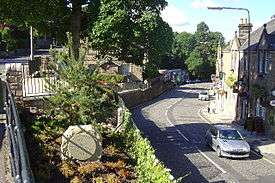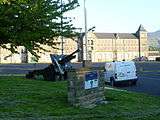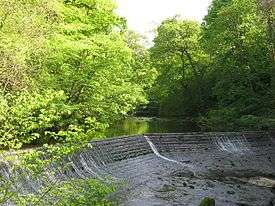Colinton

Colinton (Scottish Gaelic: Baile Cholgain) is a suburb of Edinburgh, Scotland situated 6 kilometres south west of the city centre. Up until the late 18th century it appears on maps as Collington. It is bordered by Dreghorn to the south and Craiglockhart to the north-east. To the north-west it extends to Lanark Road (the A70) and to the south-west to the City Bypass. Bonaly is a subsection of the area on its southern side.
Colinton is a designated conservation area.
History


Originally sited within a steep-sided glen on a convenient fording point on the Water of Leith, and expanding from there, Colinton's history dates back to before the 11th century.
Close to the Water of Leith is Colinton Parish Church, correctly called St Cuthbert's Parish Church, originally founded as the Church of Halis (Hailes) around 1095 by Elthelred, third son of Malcolm III and Queen Margaret. The current exterior largely dates from 1907 but the structure dates from 1650.[1] The entrance is marked by a lych gate, rare in Scotland and more common in southern England. The cemetery (on the lower slopes to the south) contains the village war memorial. One unique grave within the cemetery is a Norwegian War Grave.
The nearby 15th century Colinton Castle, in the grounds of what is now Merchiston Castle School, was destroyed by Oliver Cromwell during his invasion of Scotland. Following repair, the castle was subsequently partially demolished by the artist Alexander Nasmyth in order to create a picturesque ruin.
Other notable figures with connections to Colinton include: Robert Louis Stevenson who spent the summers of his childhood at the manse when his grandfather was the village's Parish Minister; the philanthropist James Gillespie; and architects Sir Robert Rowand Anderson and John James Burnet,[2] who all lived in the village.

A number of innovative Arts and Crafts style cottages were also constructed in the village in the early 1900s by the architect Sir Robert Lorimer. Between 1909 and 1915, the War Office constructed Redford Barracks to the east of the village. The barracks represent the largest military installation built in Scotland since Fort George in the Highlands and they provide military accommodation, together with offices and training facilities. As part of the UK government's defence spending review, Redford and Dreghorn Barracks are deemed surplus to requirements and earmarked for disposal.[3]
The village was the location for mills producing textiles, snuff, and paper. The Caledonian Railway Company constructed a new spur line connecting Slateford and Balerno in 1874, with a station at Colinton. This line continued to carry passenger traffic until 1943, and finally closed when the carriage of freight was discontinued in the 1960s.
Colinton today
Today, Colinton is a suburb in Edinburgh. The original heart of Colinton is still referred to as "Colinton Village", with small speciality shops and many original buildings remaining intact.

The Dell extends along the Water of Leith Walkway from Colinton Parish Church towards Slateford, and contains a mixture of mature and ancient woodland. It is a natural habitat for wildlife. The walkway and cycle path pass by original mill buildings and old tunnel that dates back to when the path was part of the local railway line. Spylaw Park is situated within the area.
Colinton is served by Bonaly Primary School, Firrhill High School. Merchiston Castle School, east of the village, is an independent all-boys boarding school.
The major route to the city centre, Colinton Road, runs from Colinton through Craiglockhart to Holy Corner, a part of Burghmuirhead between Morningside and Bruntsfield. Along the road are a number of significant Victorian and Edwardian villas, some of which were designed by Edward Calvert.
Ethnicity
| Colinton compared | Colinton | Edinburgh |
|---|---|---|
| White | 95.0% | 91.7% |
| Asian | 2.6% | 5.5% |
| Black | 0.7% | 1.2% |
| Mixed | 0.6% | 0.9% |
| Other | 0.7% | 0.8% |
Transport
- See also Transport in Edinburgh
The following bus routes, operated by Lothian Buses pass through Colinton village, and the surrounding roads:
- Number 10 Bus — Western Harbour (through city via Princes Street) to Bonaly / Torphin
- Number 16 Bus — Silverknowes (through city via Princes Street) terminates at Colinton
- Number 18 Bus — Royal Infirmary at Little France (through suburbs) to The Gyle Shopping Centre
- Number 45 Bus — Heriot-Watt University Riccarton Campus to Queen Margaret University Musselburgh Campus via South and North bridges
Famous residents
- Archibald Alison (author) - Scottish didactic and philosophical writer
- John Allen (historian) - eighteenth and nineteenth century political and historical writer
- Henry Mackenzie - Scottish novelist
- Lord Cockburn - Scottish judge and biographer
- John MacWhirter - Scottish landscape painter.
- Calum Elliot - Professional footballer
- James Gillespie (philanthropist)
- Fred Goodwin - former CEO of Royal Bank of Scotland, bought former house of Graeme Souness[4]
- Mo Johnston - Professional footballer and manager
- Pallavi Bedi - Scientist at University of Edinburgh
- Loudon MacQueen Douglas FRSE - antiquarian and author
See also
| Wikimedia Commons has media related to Colinton, Edinburgh. |
These areas are sometimes taken to be parts of Colinton, or to be neighbouring areas in their own right:
External links
- Colinton on the Gazeteer for Scotland
- Colinton Parish Church Website
- Firhill High School Website
- Merchiston Castle School Website
- Water of Leith Website
References
- ↑ Buildings of Edinburgh, by Colin McWilliam
- ↑ JJ Burnet retired to 55 Woodhall Road where he died in 1938"Three cottages, Woodhall Road". Dictionary of Scottish Architects. Retrieved 2008-11-21.
- ↑ House of Commons Library: Standard Note:SN06038
- ↑ McBeth, Jim (9 June 2010). "Fred the Shred is back: Shamed RBS boss returns to country he nearly bankrupted after buying £3.5m 'WAG dream house'". Daily Mail. London.
Coordinates: 55°54′30″N 3°15′00″W / 55.90833°N 3.25000°W
